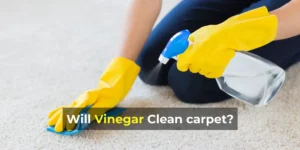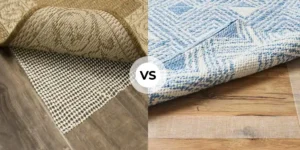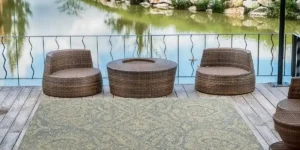A gap between the floor and the wall can be a safety hazard.
It can cause issues with soundproofing, insulation, and moisture control.
Filling the gap would be the most effective way to increase the room’s safety and maintain its quality.
Covering a gap between the floor and the wall is not an easy task.
You can use many different materials to cover this space, and each material has its pros and cons.
To find the most suitable option for your home, there are a few things you need to consider.
- First, you need to decide if you want something permanent or temporary.
- Second, you must consider what kind of space it is – open or enclosed – as this will affect the material used.
- Third, you should consider the cost of materials and the time it will take for installation.
Lastly, consider your preferences when decorating with color or texture.
These options may be limited depending on the type of material chosen.
Fortunately, it is possible to fix the gaps in various ways. Read the full article to find out how to cover the floor and wall gaps.
You Might Like:
- Can I Use Laminate Flooring On Walls? (Installation Guide Included)
- How to Fix Gaps in Vinyl Plank Flooring? (5 Easy Steps)
4 Best Ways to Cover Gap Between Floor and Wall
1. Caulking
The first method is caulking. It is the most popular method of dealing with gaps in a household.
Caulking is the process of sealing structural or piping gaps. Or seams using a material called caulk.
The purpose of caulking in modern construction is to prevent water, air, dust, and insects from entering through gaps.
Caulking is commonly used in residential homes. According to Energy.gov, caulking can prevent water damage inside and outside the home.
By sealing faucets, ceiling fixtures, water pipes, drains, bathtubs, and other plumbing fixtures.
Must See: Can you Caulk Around Vinyl Flooring? (All You Need to Know!)
What Type of Caulk is Best for Filling the Gap Between the Floor and the Wall?
Silicone (Best for Filling Gaps)
Silicone caulk is used in the construction, plumbing, and automotive industries to seal cracks and fill gaps.
It is usually white or clear, but other colors are also available. This product can be used both indoors and outdoors.
The most common application for silicone caulk is in kitchens and bathrooms.
But it can also be used on windows and decks. When exposed to water, it won’t shrink or crack.
Compared to other types of caulk, they are highly durable.
Acrylic latex
This is the most common type of caulk used for general purposes. It combines the properties of both acrylic and latex.
It is pretty inexpensive and also the easiest to apply. You can even cover it with paint later, and it won’t be damaged.
Since it does not need any tools or skills to apply, it is an excellent alternative to silicone caulk.
Also See: Do You Put Vinyl Flooring Under Appliances? (Answered & Explained)
Foam Caulk
The foam caulk alternative to liquid sealants is made of a non-aqueous compound.
The sealant is more accessible than traditional liquid sealants. It uses expanding foam as the sealant instead of a liquid sealant.
Since it offers many advantages over traditional caulking methods.
It has only recently become popular with consumers. Among these advantages are ease of application and resistance to water damage.
Butyl-Rubber Caulk
Butyl-rubber caulk is used for sealing cracks and leaks in the home.
Typically, it is used around windows, doors, and other areas around the house where seals are needed.
After drying, it forms a flexible seal that fits into tight spaces.
Steps to Fill Gaps between Floor and Wall Using Caulk
- Tape The Sides: Cover the floor with painter’s tape. Before applying caulk to prevent staining of the floorboards. It will simplify the process and make caulking lines easier to control.
- Apply Caulk to Seal the Gaps: Apply the caulk to the gap and move the tube slowly. To maintain an even flow, tap the trigger once the caulk starts pouring. Ensure that only enough caulk is applied to cover the area.
- Smoothen the Surface: A caulking tool can be used to smooth the caulk in the gap and create a uniform layer. Seal the joint with caulk, wiping away any excess.
- Let It Dry: After the caulk has dried, clean the opening and allow it to breathe. The caulk should be removed after it has dried.
- Sand the Surface: To achieve a uniform finish, sand the wood filler after it has dried.
2. Using joint compound
Another popular and effective way to fill gaps between the floor and the wall is to use a joint compound.
It is also called drywall compound or drywall mud.
A common compound is composed of gypsum dust and white powder.
Combined with water, it forms a paste-like consistency that seals joints when used with fiber or paper joint tape.
No matter what type of flooring you have, it works perfectly.
You can even color the joint compound to match your wall.
You will first need to mix white cement with water and make a paste.
It would be perfect to clean the gap before filling it with the compound.
Next, using a putty blade, you have to start filling in the gaps with the mixture. Make sure not to leave behind any air bubbles.
After applying, clean off the extra compound with a cleaning cloth or a sponge and let it dry.
Must See: The Best Way to Level a Concrete Floor For Laminate Flooring (Must Read!)
How to Cover the Gap Between Floor and Wall Using Joint Compound?
The first and most important thing is to gather all the necessary tools that will be used throughout the process.
Supplies Needed:
- Joint compound
- Painters tape
- Drywall Joint Knife
- Leveler
- Make the Mixture: Prepare the Mixture: To get started, prepare the mixture. The paste should be made in large quantities to apply it generously.
- Tape the Baseboards with Masking Tape: To protect the baseboards from joint compounds. Apply painter’s tape around them.
- Apply the Joint Compound: A joint compound with an ordinary drywall knife is recommended. Make sure that the wall is level and that the gap is filled. Use enough paste to fill in any holes.
- A Finishing Touch: After applying the compound, remove the masking tape so the mixture won’t stick to the baseboard after it dries. To complete the project, paint it the same color as the rest of the wall.
Re-installing the Baseboard
There is another method to fill in the gaps between the floor and the wall if you do not want to use sealants.
Re-install your baseboards after removing them. The process is simple, and you only need a few essential tools.
Supplies Needed:
- Hammer
- Utility knife
- Putty knife
- Pliers
- Small pry bar
- Pencil
- Finishing nails
- Nail gun
- Nail set
Start by inspecting the existing baseboard for caulk and mold.
Use a putty knife to loosen the existing baseboards by placing them between the top edge and the wall.
It is important not to crack the top portion of the board by accident. Remove the nails, if any, after the panels have been loosened.
Ensure you number each baseboard when you remove it so that it looks the same as before when you replace it.
Let the paint dry before re-installing them. Coat them with a fresh coat of paint before re-installing them.
Afterward, nail the numbered boards to the wall carefully.
Now that the baseboards are back in place, there are no gaps between the floor and the wall.
Using Backer Rod
The gap between your wall and floor can be filled with backer rods if it is significant.
The backer rod is a long foam cylinder that can be squeezed into gaps. To attach a backer rod to a wall, press the rod into any cracks larger than 1/4″.
Use the Caulk to seal the gap.
A backer rod is unnecessary if the gap is smaller than 1/4″. Caulk usually fills gaps from 1/2″ to 2″.
The backer rod comes in various thicknesses to fit different gap sizes.
You can also use the filler strip to fill the large gap between the floor and the baseboard.
Plywood is an affordable option for a filler strip. It can be cut to size and sanded down until it matches the wood of your baseboard.
FAQs: How to Cover the Gap Between the Floor and the Wall?
Can I caulk between the floor and the baseboard?
Yes, you can caulk between the floor and the baseboard.
Caulking is an excellent way to seal up gaps and cracks that may let in air, water, or other substances.
Secondly, it will help prevent mold from growing between the floor and the baseboard.
Lastly, caulking is typically applied with a caulk gun, making it easier for you to use it evenly throughout the area.
How do I fill a large gap between the floor and the baseboard?
When you have a large gap between the floor and the baseboard, you don’t need to replace the whole baseboard.
You can fill it with a filler strip or backer rod.
You can also use wood putty or Caulk to fill the gap between the floor and baseboard.
It will require sanding, but it should blend in with your existing baseboard.
How do I hide the gaps under my baseboards?
The gaps under the baseboard are an eyesore and can be a place for dust to accumulate.
You can use these steps to hide the cracks under your baseboards:
1) Measure the height of your baseboard. Cut a piece of wood the same size as your baseboard but 1 inch shorter than its width.
2) Paint or stain your piece of wood, so it matches the color of your walls.
3) Place it on top of the gap under your baseboard, with one side touching the wall and one hanging over.
Screw it in place with finishing nails or screws that are long enough to go through both pieces of wood and into drywall or plaster behind them.
Check Out More Articles Related to Flooring
- Can you Caulk Around Vinyl Flooring? (All You Need to Know!)
- How to Fix Side Gaps in Laminate Flooring? (5 Best Ways)
- How to Fix Gaps in Vinyl Plank Flooring? (5 Easy Steps)
- Cork vs. Foam Underlayment: Which is Right for Me?
- 5 Reasons Why Your Vinyl Plank Floor Buckling (Guide To Fix It)





